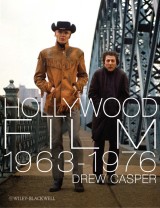Details

Hollywood Film 1963-1976
Years of Revolution and Reaction1. Aufl.
|
31,99 € |
|
| Verlag: | Wiley-Blackwell |
| Format: | |
| Veröffentl.: | 23.02.2011 |
| ISBN/EAN: | 9781444395228 |
| Sprache: | englisch |
| Anzahl Seiten: | 400 |
DRM-geschütztes eBook, Sie benötigen z.B. Adobe Digital Editions und eine Adobe ID zum Lesen.
Beschreibungen
<i>Hollywood 1963-1976</i> chronicles the upheaval and innovation that took place in the American film industry during an era of pervasive cultural tumult. Exploring the many ideologies embraced by an increasingly diverse Hollywood, Casper offers a comprehensive canon, covering the period's classics as well as its brilliant but overlooked masterpieces. <ul> <li>A broad overview and analysis of one of American film's most important and innovative periods</li> <li>Offers a new, more expansive take on the accepted canon of the era</li> <li>Includes films expressing ideologies contrary to the misremembered leftist slant</li> <li>Explores and fully contextualizes the dominant genres of the 60s and 70s</li> </ul>
Acknowledgments. <p>List of Illustrations.</p> <p>Foreword<b>.</b></p> <p><b>Part I:</b> <b>Cultural Overview: The Years of Revolution and Reaction, 1963–76:</b></p> <p><b>1. Major Historical Events.</b></p> <p>Civil Rights Legislation and Protests.</p> <p>The Vietnam War.</p> <p>Law and Order.</p> <p><i>Realpolitik.</i></p> <p><b>2. Economic Situation.</b></p> <p>Expanse and Contraction.</p> <p>Downturn.</p> <p><b>3. Societal Issues.</b></p> <p>The New Left, the Counterculture, Neo-Conservatism, and the Silent Majority.</p> <p>Ecology, Good Health, and Fitness.</p> <p>Scientific/Technological Advances.</p> <p>Conglomerate Ascendancy.</p> <p>Media Society.</p> <p>Crime.</p> <p>Religion.</p> <p>A Sense of Confusion, Impotence, and Cynicism, and a Wave of Nostalgia.</p> <p><b>Part II: Business:</b></p> <p><b>4. Production–Distribution.</b></p> <p>Showmen, Caretakers, and Conglomerates.</p> <p>The Practices of the Seven Major Studios: Lesser Movies, Higher Costs, Independent/Runaway Production, Sources, Stars, Sequels/Series, Mainstreaming Exploitation, “The Big Kill,” “The Youth Movie,” “A Film By,” Diversification.</p> <p>Competition: Minor and New Studios.</p> <p>The Financial Bloodbath.</p> <p>Additional Practices: Downsizing, Negative Pickup, Co-Production/Distribution, Tax Breaks/Shelters.</p> <p>Still Other Gambits: The Nostalgic Wave and The “Special Event” Movie.</p> <p>Distribution.</p> <p>Black Groundswell.</p> <p>Academy Awards.</p> <p><b>5. Exhibition and the New Audience.</b></p> <p>Exhibition.</p> <p>The New Audience.</p> <p><b>Part III: Technology:</b></p> <p><b>6. Color, Screen Shapes, Sound, Special Effects, and Production Refinements.</b></p> <p>Color.</p> <p>Screen Shapes.</p> <p>Sound.</p> <p>Special Effects.</p> <p>Production Refinements.</p> <p><b>Part IV: Style:.</b></p> <p><b>7. Documentary and Documentary Realism.</b></p> <p><b>8. TV and TV Theatrical.</b></p> <p><b>9. Modernism, TV Programming/Commercials, the Avant-Garde, and Expressive Stylization</b>.</p> <p>Literary Design.</p> <p>Performance.</p> <p>Visual Design.</p> <p>Composition.</p> <p>Temporal Design.</p> <p>Sound Design.</p> <p><b>Part V: Censorship:.</b></p> <p><b>10. Issues, Solutions, and Problems.</b></p> <p>Subsidiary Syndrome.</p> <p>Two-Version Ploy.</p> <p>Dilemma: <i>The Pawnbroker</i> (AA, 1965).</p> <p>Turning Point: <i>Who’s Afraid of Virginia Woolf?</i> (WB, 1966).</p> <p>The 1966 Production Code Guidelines and the “SMA” Category.</p> <p>Ratings System.</p> <p>Enlightenment of the Legion of Decency.</p> <p>Divorce: Hollywood and the Church.</p> <p>City/State Censorship and the Liberalization of the Supreme Court.</p> <p>City/State Censorship vs. Hollywood.</p> <p><b>Part VI: Genre:.</b></p> <p><b>11. Adventure.</b></p> <p><b>12. Biography.</b></p> <p><b>13. Historical Spectacle.</b></p> <p><b>14. Comedy.</b></p> <p>Black Comedy.</p> <p>Farce.</p> <p>Parody.</p> <p>Social Satire.</p> <p>Romantic Comedy.</p> <p>Family Comedy.</p> <p>Fantasy Comedy.</p> <p><b>15. Horror and Science Fiction.</b></p> <p>Horror.</p> <p>Science Fiction.</p> <p><b>16. Melodrama.</b></p> <p>Family Melodrama.</p> <p>Road Film and Biker Film.</p> <p>Female Melodrama.</p> <p>Male Melodrama.</p> <p>Romance Melodrama.</p> <p>Buddy Film.</p> <p><b>17. Musical.</b></p> <p>Musical Comedy and Musical Drama.</p> <p>Musical Biography.</p> <p><b>18. Social Problem Film and Courtroom Drama.</b></p> <p>Social Problem Film.</p> <p>Courtroom Drama</p> <p><b>19. Suspense Thriller.</b></p> <p>Spy Thriller: WWII/Cold War.</p> <p>Crime.</p> <p>Vigilante.</p> <p>Caper.</p> <p>Conspiracy.</p> <p><b>20. War</b></p> <p><b>21. Western.</b></p> <p><b>Coda: Postmodern Hollywood, 1977.</b></p> <p>Appendix: Hierarchical Order of Ten Box-Office Stars, 1963–76.</p> <p>Bibliography.</p> <p>Index.</p>
"I highly recommend this book to any film student or person interested in Hollywood films of the 60s and 70s. This text will definitely become a go-to reference as I continue my studies.." (Breitbart.com, 2011)
<span style="font-size: 10pt; line-height: 115%; font-family: Cambria; mso-ansi-language: EN-US; mso-fareast-font-family: Calibri; mso-bidi-font-family: 'Times New Roman'; mso-bidi-font-size: 11.0pt; mso-fareast-language: EN-US; mso-bidi-language: AR-SA;"><b>Drew Casper</b> is the Alma and Alfred Hitchcock Chair of American Film at the University of Southern California’s School of Cinematic Arts. He is the author of</span> <span style="font-size: 10pt; line-height: 115%; font-family: Cambria; mso-ansi-language: EN-US; mso-fareast-font-family: Calibri; mso-bidi-font-family: 'Times New Roman'; mso-bidi-font-size: 10.5pt; mso-fareast-language: EN-US; mso-bidi-language: AR-SA;"><i>Postwar Hollywood, 1946-1962</i> (Blackwell, 2007), <i>Introduction to Film Reader</i> (2007), <i>Stanley Donen</i> (1983), and <i>Vincente Minnelli and the Film Musical</i> (1977). He has contributed on many DVD commentaries for documentaries of classic and contemporary Hollywood films.</span>
<span style="font-size: 10pt; line-height: 115%; font-family: Cambria;"><span style="font-size: 10pt;"><i>Hollywood 1963-1976: Years of Revolution and Reaction</i></span> <span style="font-size: 10pt;">is a comprehensive study of one of the most tumultuous eras in American film, chronicling the collapse of the studio system, the rise of the auteur, and the birth of the blockbuster. Drew Casper’s maximalist review draws wide and varied examples from an expanded canon to discuss technological innovations, changing standards of censorship, and the broad spectrum of ideologies that found their way onto the reel, mirroring the nation's own divided and frequently schizophrenic politics. </span></span>

















